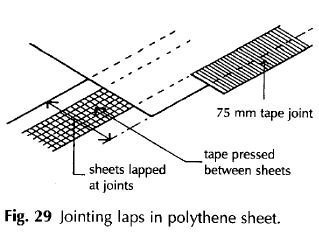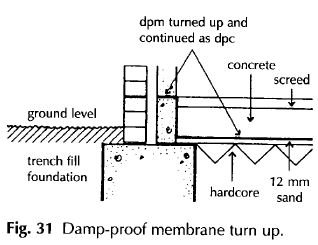Polythene or polyethylene sheet is commonly used as a {damp-proof membrane} with oversite concrete for all but severe conditions of dampness. It is recommended that the sheet should be at least 0.25 mm thick (1200 gauge). The sheet is supplied in rolls 4 m wide by 25 m long. When used under concrete oversite the sheet should be laid on a {blinding} layer of sand or compacted fuel ash spread over the {hardcore}.
The sheets are spread over the blinding and lapped 150 mm at joints and continued across surrounding walls, under the dpc for the thickness of the wall.
Where site conditions are reasonably dry and clean, the overlap joints between the sheets are sealed with mastic or mastic tape between the overlapping sheets and the joint completed with a polythene jointing tape as illustrated in Fig. 29.

For this lapped joint to be successful the sheets must be dry and clean else the jointing tape will not adhere to the surface of the sheets and the joint will depend on the weight of the concrete or screed pressing the joint sufficiently heavily to make a watertight joint. As clean and dry conditions on a building site are rare, this type of joint should be only used where there is unlikely to be heavy absorption of ground moisture.
Where site conditions are too wet to use mastic and tape, the joint is made by welting the overlapping sheets with a double welted fold as illustrated in Fig. 30, and this fold is kept in place by weighing it down with bricks or securing it with tape until the screed or concrete has been placed. The double welt is formed by folding the edges of sheets together and then making a welt which is flattened.

The plastic sheet is effectively impossible to fold and so stiff and elastic that it will always tend to unfold so that it requires a deal of patience to fold, hold in place and then contrive to fold along the joint. By using the maximum size of sheet available it is possible to minimise the number of joints.
The sheet should be used so that there are only joints one way as it is impractical to form a welt at junctions of joints.
Where the level of the {damp-proof membrane} is below that of the dpc in walls it is necessary to turn it up against walls so that it can overlap the dpc or be turned over as dpc as illustrated in Fig. 31. To keep the sheet in place as an upstand to walls it is necessary to keep it in place with bricks or blocks laid on the sheet against walls until the concrete has been placed and the bricks or blocks removed as the concrete is run up the {wall}.

At the internal angle of walls a cut is made in the upstand sheet to facilitate making an overlap of sheet at corners. These sheets which are commonly used as a damp-proof membrane will serve as an effective barrier to rising damp, providing they are not punctured or displaced during subsequent building operations.